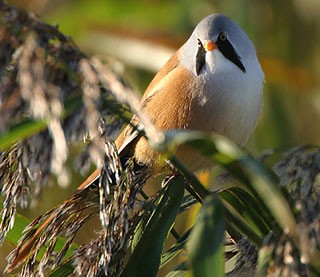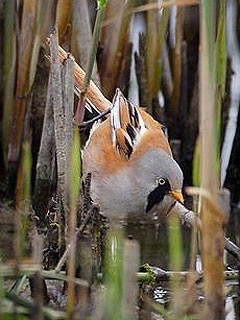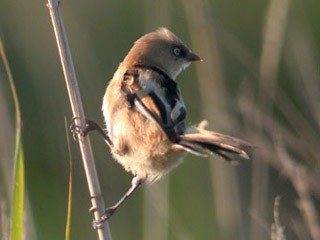 |
| Bearded Tit: Titchwell, Norfolk Aptly named, the male is a stunning bird. (photo: Steve Round). |
 |  |
| Bearded Tit: Titchwell, Norfolk Typically skulking, they spend much of their time at the reed base, their presence often only betrayed by 'pinging' call. (photo: Sean Gray). | Bearded Tit: Grimley, Worcs Females are drabber, and lack the black moustache of the male. (photo: Andy Warr). |
With its striking appearance and exotic looks, the Bearded Tit looks out of place in a British environment. A member of the parrotbills familiar to travellers in Asia, it is the only representative of the Timaliidae family in Western Europe. The breeding range reaches from Britain and Spain in the west, eastwards across the Palearctic to northern China. Distribution is patchy in the west, restricted due the fact that it occurs only in lowland reedbeds during the breeding season.
The British breeding population numbers around 400 pairs, the bulk of which is in large reedbeds near the east coast of England and along the south coast. There is also a population in Lancashire (first colonised in 1973) and in the Tay reedbeds in Scotland. Bearded Tits have also bred in Co. Wicklow in Ireland and in 2005 bred at the Newport Wetlands Reserve (Gwent); this is the first time the species has bred in Wales since the early 1980s.
 |  |
| Bearded Tit: Grove Ferry, Kent Autumn flocks can be sizeable, and highly mobile. (photo: John Reeves). | Bearded Tit: Titchwell, Norfolk (photo: Alan Wadsworth). |
Following the breeding season, birds form autumn flocks from mid-September onwards. A visit to a breeding reedbed at this time of year can provide an amazing experience as groups fly high above the reedbed, a disruptive commotion in the still autumn morning. Autumn movement takes place through October and into November. It is at this time of year that birds turn up 'out of range' at any patch of suitable habitat, often in very small stands of reeds. Despite their gaudy appearance, Bearded Tits can be exceptionally elusive and are usually most easily located by their ringing 'ping, ping' call. During the winter months some of these passage birds may remain, but most move on, and the main wintering sites are in the same reedbeds that hold the species during the summer months.
Ringing studies have shown that during the winter the British population shifts to the west, and some continental birds have been found in British reedbeds. Bearded Tits are particularly susceptible to hard weather, and mild winters impact favourably on the species. Additionally, as for any species with a specialised choice of habitat, they are also highly susceptible to habitat destruction or damage.
 |
| Bearded Tit: Titchwell, Norfolk (photo: Sean Gray). |
- Leighton Moss, Lancashire: SD478751.
- Blacktoft Sands, E. Yorks: SE8423.
- Titchwell RSPB, Norfolk: TF749437.
- Cley NWT, Norfolk: TG0544.
- Walberswick, Suffolk: TM4773.
- Minsmere, Suffolk: TM4767.
- Stodmarsh, Kent: TR220610.
 |
| Bearded Tit: Oare Marshes, Kent Juveniles have a black back and sides to the tail. (photo: Pete Merchant). |
 |  |
| Bearded Tit: Cley, Norfolk (photo: Stephen North). | Bearded Tit: Cley, Norfolk (photo: Chris Jones). |
Juveniles resemble females, but are more buffy-coloured. They have a black back, lower mantle and inner scapulars, and mostly black primary, lesser, median and greater coverts. In addition they have black areas on the tail. Some females may show blackish streaks on the back (and crown), but not to the extent of juveniles. Juvenile males have black lores and an orangey-yellow bill. Juvenile females have greyish or brownish lores and a dark bill.
A national census of the species in 2002 produced a total of 504-559 pairs (Rare Breeding Birds Panel). Of these, 38-45 pairs were in southwest England; 105-123 pairs in southeast England; 295-314 pairs in Eastern England; 52-56 pairs in Northern England; 0-1 pairs in Wales and; 14-20 pairs in Mid Scotland.
In Lancashire birds first colonised Leighton Moss in 1973 and a population of perhaps 40 pairs formerly bred there (Wilson, 1993), but a population crash in 2001 has markedly reduced this number (Rare Breeding Birds Panel, 2004).
In Yorkshire, between 40-65 pairs breed at Blacktoft Sands, but post-breeding numbers often total several hundred birds, and in 1990 it was estimated that 1,000 young birds were reared at the site (Yorkshire Bird Reports).
In Norfolk a co-ordinated survey in 1992 revealed a total of 94-115 pairs at 10 locations, well down on the peak breeding population in the county of 240 pairs in 1980. For example a colony at Hickling Broad and Heigham Sound contained 108 pairs in 1980, 60 pairs in 1985, and 25 pairs in 1998 (Birds of Norfolk).
In Suffolk the population was estimated at 43-52 pairs (Birds of Suffolk). The Rare Breeding Birds Panel report 120-132 pairs in 2002.
References
Bibby, C. J. 1983. Studies of West Palearctic birds: Bearded Tit British Birds 76:549-562
Campbell, L.A. et al. 1996. Bearded Tit in Britain and Ireland British Birds 89:335-346
Ogilvie, M and the Rare Breeding Birds Panel. 2004. British Birds 97: 492-536.
Wernham, C., et al. 2002. The Migration Atlas: Movements of the birds of Britain and Ireland. T and AD Poyser, London.
Wilson, J. 1993. Colonisation by Bearded Tits of Leighton Moss, Lancashire British Birds 86:352-358


